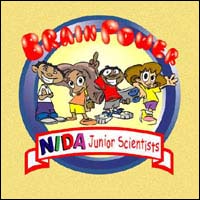In the past few years, NIDA has increased its efforts to provide drug abuse education materials for students and teachers. Part of NIDA’s mission is to increase students’ knowledge of drug abuse and addiction; the education efforts also encourage interest in science as a discipline and a career.
“Brain Power!”

The newest member of NIDA’s family of materials for students and teachers is the “Brain Power!” program. Designed for second- and third-grade children and their teachers, the program contains six modules that help students explore the processes of science and give them accurate information about drug abuse.
Teachers are provided with a guide containing detailed instructions, background information, and lesson planning materials. Student materials include worksheets and colorful trading cards. Each module also has a newsletter for parents with information on what the students are learning, information on drugs and drug addiction, and suggested activities for parents to do with their children.
“We’re very excited about these materials,” says Dr. Cathrine Sasek, science education coordinator in NIDA’s Office of Science Policy and Communications. “Each module’s content is aligned with the National Science Education Standards released by the National Research Council. These standards outline the student knowledge and skills that are necessary for science literacy at different grade levels. The modules will help lay the foundation for good health choices and encourage children’s interest in science.”
“NIDA Goes to School”
NIDA’s science education materials for middle and junior high school students, originally packaged in the “NIDA Goes to School” kit, are still available. They include the eight Mind Over Matter magazines featuring the cartoon adventures of Sara Bellum, who explores the brain’s response to particular drugs and introduces key concepts of neuroscience. The series includes magazines on marijuana, opiates, stimulants, steroids, inhalants, hallucinogens, methamphetamine, and nicotine. A 40-page teacher’s guide provides teachers with tools they can use in their classes.
The materials are also featured on NIDA’s Web site. After reading the Mind Over Matter materials, students can use the interactive Web site (http://teens.drugabuse.gov/sarasquest/index.php) to join “Sara’s Quest,” a game that asks questions about the effects of the drugs covered in the series. Students who answer all of the questions correctly can receive a free poster.
“Understanding the Neurobiology of Addiction”
Working with the Office of Science Education of the National Institutes of Health (NIH), NIDA has developed a free educational resource for high school students and teachers. “The Brain: Understanding the Neurobiology of Addiction” is designed to provide current scientific information about drug abuse and addiction to high school students and teachers.
The supplement covers how the brain works, how drugs affect the brain, and how particular drugs alter neurochemicals and interact with the brain’s reward system. It includes a teacher’s manual with background materials, a glossary, and a list of additional resources.
NIDA is working closely with the National Association of Biology Teachers (NABT) to distribute the curriculum as widely as possible.
To Receive This Resource
- The “Brain Power!” materials will be available in fall 2001. Look for them at https://www.drugabuse.gov/brain-power
- The “NIDA Goes to School” materials are currently available and can be downloaded from NIDA’s Web site or ordered from NIDADrugPubs.
- The high school curriculum supplement will be available in fall 2001. Copies can be ordered now from the NIH Science Education Web site: https://science.education.nih.gov.
